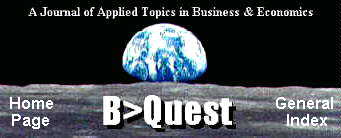B>QUEST
(Business Quest)
INDEX OF ARTICLES
(Includes an Abstract of Each)
1996
(first year of publication)

Articles By Academicians
Real Estate Brokerage And Agency:
Middlemen, Facilitators, and Transaction Brokers
Make An Appearance
by H. Glenn Boggs
This article traces the historical concept of a "middleman" in real estate transactions and
links this heritage to explanations of recent developments involving facilitators or
transaction brokers in real estate agency practice.
The Home Office Deduction
by Royce E. Chaffin and George S. (Steve) Busby
Day care operators, employees, educators, outside sales persons, certain specialist
physicians, investors, and others who incur office expenses in the home must meet the
tough rules of the Internal Revenue Code, section 280A in order to claim a tax deduction.
With limited exceptions, the deduction will not be allowed even though an allocable
portion of depreciation, utilities, insurance, etc. expenses would otherwise be allowable as
a deduction for trade or business expenses (under Section 162) or for the production of
income (under Section 212). This paper points out the exceptions that allow individuals to
claim all qualified deductions.
Forensic Economics: The Ethical Dilemma Of
Information Competition
by Charles C. Fischer
This article examines the issue of qualitative market failure in the area of forensic
economics. Focusing on the ethicality of the profession, it is argued that the weak link in
the market is information competition. The nature of the information problem is
examined, and remedial market policies are set forth. These market policies are
presented within the larger context of market and nonmarket policies. The goal is to add
to the important debate on how to ensure objective forensic economic analysis and thus
minimize the "hired-gun" effect.
An Integrated View Of The Relationship Between The
Organization And Its Environment
by Barry E. Langford and Frank R. Hunsicker
The Objective-Environment Perception and Enactment Model (OEPE) developed by the
authors provides a more realistic view of the external environment than each of the three
traditional models: objective, perceived, and enacted. The OEPE model integrates the
three perspectives with important internal factors that also affect strategic decisions. By
eliminating the flaws in each of the traditional models, uniting their strong points, and
integrating relevant internal factors, the model more clearly represents the real world of
strategic decision making.
Perceptions Of Female Sex Role Portrayals In
Advertising:
A Synthesis Of Research For Managerial Application
In The Pacific Rim
by Michael S. LaTour
Marketing managers doing business in the Pacific Rim face the difficult challenge of
marketing to women from diverse cultures. Many of these cultures are undergoing
"consciousness raising" changes on the issue of the portrayal of women in advertising.
Given the importance of women's issues to "cross-cultural" marketing efforts, a recent
stream of academic research has generated considerable amounts of data and findings
concerning female role portrayals. Yet, for practitioners, the key question is "what does
this mean for managerial decision making as to the design of advertising campaigns
targeted to women?" Towards this end, this paper provides an analysis of past studies of
perceptions of femal role portrayals along with definitive recommendations for marketing
managers in the Pacific Rim.
Factors Considered By Players In Choosing A Golf
Course
by Michael D. Richard, James B. Faircloth, and Victoria P. Richard
The purpose of this study is to develop a model of public golf course choice intentions.
Specifically, this study examines the attributes thought to influence the choice of public
golf courses by U.S. golfers. Regression analysis is employed to investigate whether 17
golf course attributes exert a significant influence on public golf course choice intentions.
Public golf course choice intentions is found to be a functionof several groups of attributes
including: the accessibility of the course, the physical attributes of the course itself, the
other individuals directly and indirectly influencing the golfer, and the extra facilities
available to the golfer at that course.
Business Practices In Academic Institutions: Can They
Succeed?
by Beheruz N. Sethna
Academic institutions have for generations regarded themselves as being above questions
of efficiency. Some institutions have preferred to collapse under their own weight, rather
than ask themselves serious questions about doing things differently and more efficiently.
Questions about efficiency--and sometimes even effectiveness--have been regarded as
being inappropriate, if not sacrilegious, with regard to academic departments and
programs. In addition, universities and colleges have long had traditions of shared
governance, which are quite different from the management methods found in industry.
The question, then, is: Can business practices, which include concepts such as
prioritization, questions of efficiency and effectiveness, redirection and reallocation of
resources, and the like, succeed in an academic institution?
The answer proposed in this paper is "yes." However, it is suggested that both process
and content are critical in a successful approach. These concepts are further developed in
this paper, and an example is described in some detail which resulted in redirecting
significant amounts of resources; while preserving the strong academic tradition of shared
governance.
Examining The Economic Competitiveness Of The
Economies Of The Southern United States
by William Seyfried
Much discussion surrounds the issue of why some states experience relatively rapid
economic growth, while others lag behind. In an attempt to find an answer to this
important question, the author of this article finds a way to measure the competitiveness
of several states in the South and then seeks out factors which explain differences in
these states' competitiveness. A dynamic shift-share analysis of Gross State Product data
is used to determine each state's competitive position. After thus obtaining the
competitive position of each of these states, factors affecting their competitiveness are
empirically tested for their significance. Taxes are found to have an insignificant impact
on competitiveness, while both wages and education have a significant impact; however,
the effect of the former is negative, while the latter's is positive.
The Market For Safety
by Mark Thornton
The market is well equipped to regulate itself. For example, the very existence of the
Underwriters Laboratory debunks the common civics-text view that without government
innovation, private businesses would seek profit without regard to safety.

Articles By Practitioners
The World On Your Desktop:
International Exposure and the Internet
by Marie Hawkins
Based on the experience of the Southwire Company in using the Internet to provide
current information and technical support to its customers, the author considers current
and future business use of the Internet.
A Practical Customer Service Solution
by Jeanne Sawyer and Peter Meyer
This is a brief, but true story, of risk and reward that shows it is a mistake to assume the
customer is always right. It is concerned with a type of problem many businesses face, but
don't want to deal with. However, it is a problem a business will probably have to deal with
sooner or later if it buys or sells complex products or advises those who do. In this article
the authors reveal some important concepts for effectively solving this type of problem
and lay out some practical steps to use in solving them.
Jigsaw Management
by Peter Meyer and Richard Meyer
What to do when the scientific method fails to provide a solution to a problem.
Go To Article.
Editorial Opinion
Misconceptions About Insurance
by Carole E. Scott
What distinguishes Social Security from private insurance is not that it transfers income,
but that it is a Ponzi scheme. Like a private pension plan, it provides retirees with money
to buy goods, but unlike the money put into a private pension plan, money paid to the
Social Security Administration does not make it possible for us to produce more goods. It
is not surprising that the costs of some health insurance plans are spinning out of control,
because insurance is not an appropriate method for covering relatively minor expenses
experienced by everybody.
New Science Validates Laissez-Faire And Draws
Attention To Little Known School Of Economic Thought
by Carole E. Scott
Hypertext makes it possible to write truly multi-dimensional articles like this one. Links
make it possible to read this article on several different levels. Which is chosen depends
on your background and interests.
The ability of computers to do an enormous number of calculations in a short period of
time has made it possible to study events which can only be modeled by a set of non-linear
equations. As a result, some events formerly considered to be random and unpredictable
have been found to display patterns. As a result of this work two new, related theories,
Chaos and Complexity, have been developed and the claim made that the latter validates
laissez faire and provides a better framework for examining the stock and bond markets
than the efficient markets hypothesis.
Economic Statistics: Good, Bad, Or Indifferent?
by Carole E. Scott
Depended upon by many for making vital decisions, are they dependable?
Go To Article.
 This icon indicates that an article was subject to peer review. (See the Guidelines
for Authors.)
This icon indicates that an article was subject to peer review. (See the Guidelines
for Authors.)
B>Quest Is Published By The

David Hovey, Dean
Carole E. Scott, Editor-in-Chief
The State
University of West Georgia
A Unit of the University System of Georgia
Beheruz N. Sethna, President
Carrollton, Georgia
U.S.A.











 This icon indicates that an article was subject to peer review. (See the Guidelines
for Authors.)
This icon indicates that an article was subject to peer review. (See the Guidelines
for Authors.)